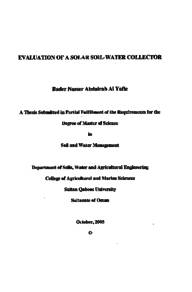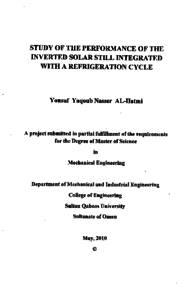Document
Evaluation of a solar soil-water collector
Publisher
Sultan Qaboos University
Gregorian
2005
Language
English
English abstract
ABSTRACT
Countries in the arid climates of the world are all suffering increasingly from water
shortages. In oil producing countries, governments often invest in large desalination plants
to overcome water shortages. Desalinated water, nevertheless, is expensive, and people are
encouraged to conserve water in their everyday use. This study aims to demonstrate that
soil water that has previously been considered irretrievable can be collected, by harnessing
the power of the sun to retrieve water from wet soil using a rugged metal collector sunk
into the ground. Specifically the experimental goals of this study were to determine the
effects of environmental factors on the amount of soil water collected as a condensate in
the specially designed solar powered apparatus. These factors included, soil type, air
temperature, and soil water content. In addition, properties of the soil water collector were
adjusted in order to maximize the amount of condensate. The amount of water collected
depended largely on the air temperature and soil water content. In winter 465 ml m2 day!
were collected compared to 1163 ml m2 day in summer. However, the initial soil water
content was equally important; dry soil tended to yield less condensate than wet soil. Saturated soils yielded 814 ml m2 day in winter compared to 1395 ml m2 day in
summer. The type of soil also affected the release of water from the surface, as a result of
differences in soil water release characteristics. The air space between the soil surface and
the condensate collecting surface also had an effect on condensate collection within
experimental limits, the greater this distance, the more the condensate that was collected.
However, the amount decreased over time. The configuration of the condensate collecting
surface also had an effect on the amount of condensate obtained, the shallower the angle of
the surface, the more condensate was collected. Collection of soil water condensate was
feasible under the conditions investigated. The amounts of collected condensate can be of
agricultural significance especially in coastal areas when mixed with sea water to support
some salt and drought tolerant crop. The designed collector was most effective in the
summer, with wet poorly-drained silt soils, on cloudless days.
Member of
Resource URL
Arabic abstract
الخلاصة
تعاني الدول في المناطق الجافة من العالم على نحو متزايد من نقص المياه. وتستثمر الحكومات في الدول المنتجة للنفط، مبالغ طائلة في وحدات تحلية المياه للتغلب على نقص المياه على الرغم من هذا، فأن التكلفة العالية التحلية المياه تحفز الحكومات على ترشيد استهلاك المياه في الاستخدام اليومي تهدف هذه الدراسة إلى تقصي إمكانية استرجاع المياه المخزونة في التربة الرطبة، و التي كانت سابقا غير قابله للاسترجاع، بتسخير الطاقة الشمسية وذلك عن طريق جامع معدني مدفون في التربة الأهداف التجريبية من هذه الدراسة تحدد تأثير العوامل البيئية على كمية مياه التربة التي جمعت كمياه مكثفه في جهاز مشغل شمسي مصمم خصيصا لهذا الغرض. هذه العوامل البيئية تكمن في نوع التربة، درجة الحرارة الجوية، و المحتوى الرطوبي للتربة وبالإضافة إلى ذلك فإن مميزات جامع مياه التربة يمكن أن يزيد من كميات المياه المكثفة. تعتمد كميات المياه المجمعة بشكل كبير على درجات الحرارة الجوية ومحتوى الرطوبة في التربة. في الشتاء تم جمع 465 مليلتر لكل متر مربع من المشغل في اليوم الواحد من المياه المكثفة مقارنة إلى ۱۱۹۳ مليلتر لكل متر مربع في اليوم الواحد في الصيف. على أية حال، فإن محتوى ماء التربة الأولي مهم على حد سواء؛ فإنتاج التربة الجافة من المياه المكثفة أقل بكثير من الثرية قارب أنتاج الثرة المشبعة من المياه ۸۱4 مليلترا في الشتاء مقارنة ب ۱۳۹۰ مليلترا لكل متر مربع من المشغل في اليوم الواحد في الصيف نوع التربة كان مؤثرا على تحرير الماء من السطح، نتيجة للخصائص المختلفة لنوعية التربة، والمجال الهوائي بين سطح التربة، وسط تجمع المياه المكثفة. كل هذه العوامل كان لها تأثير على تجميع كمية المياه المكثفة ضمن حدود التجربة، فكلما زادت المسافة، زادت كمية المياه المجمعة، ولكن تقصت الكميات بمرور الوقت. ضبط سطح تجمع المياه المكثفة أيضا له تأثيره على كمية المياه المجمعة؛ فكلما زادت زاوية السطح، زادت كمية المياه المجمعة. أثبتت التجربة أن عملية جمع مياه التربة المكثفة ممكنة تحت ظروف معينة، ويمكن أن تكون لكمية المياه المكثفة أهمية زراعية، خاصة في المناطق الساحلية عند خلطها بماء البحر لتوفير الكميات اللازمة للنباتات المقاومة الملوحة والجفاف. الجامع المصمم كان أكثر فاعلية في الصيفي، و في التربة الرطبة قليلة التصريف المائي، وفي الأيام الصافية.
تعاني الدول في المناطق الجافة من العالم على نحو متزايد من نقص المياه. وتستثمر الحكومات في الدول المنتجة للنفط، مبالغ طائلة في وحدات تحلية المياه للتغلب على نقص المياه على الرغم من هذا، فأن التكلفة العالية التحلية المياه تحفز الحكومات على ترشيد استهلاك المياه في الاستخدام اليومي تهدف هذه الدراسة إلى تقصي إمكانية استرجاع المياه المخزونة في التربة الرطبة، و التي كانت سابقا غير قابله للاسترجاع، بتسخير الطاقة الشمسية وذلك عن طريق جامع معدني مدفون في التربة الأهداف التجريبية من هذه الدراسة تحدد تأثير العوامل البيئية على كمية مياه التربة التي جمعت كمياه مكثفه في جهاز مشغل شمسي مصمم خصيصا لهذا الغرض. هذه العوامل البيئية تكمن في نوع التربة، درجة الحرارة الجوية، و المحتوى الرطوبي للتربة وبالإضافة إلى ذلك فإن مميزات جامع مياه التربة يمكن أن يزيد من كميات المياه المكثفة. تعتمد كميات المياه المجمعة بشكل كبير على درجات الحرارة الجوية ومحتوى الرطوبة في التربة. في الشتاء تم جمع 465 مليلتر لكل متر مربع من المشغل في اليوم الواحد من المياه المكثفة مقارنة إلى ۱۱۹۳ مليلتر لكل متر مربع في اليوم الواحد في الصيف. على أية حال، فإن محتوى ماء التربة الأولي مهم على حد سواء؛ فإنتاج التربة الجافة من المياه المكثفة أقل بكثير من الثرية قارب أنتاج الثرة المشبعة من المياه ۸۱4 مليلترا في الشتاء مقارنة ب ۱۳۹۰ مليلترا لكل متر مربع من المشغل في اليوم الواحد في الصيف نوع التربة كان مؤثرا على تحرير الماء من السطح، نتيجة للخصائص المختلفة لنوعية التربة، والمجال الهوائي بين سطح التربة، وسط تجمع المياه المكثفة. كل هذه العوامل كان لها تأثير على تجميع كمية المياه المكثفة ضمن حدود التجربة، فكلما زادت المسافة، زادت كمية المياه المجمعة، ولكن تقصت الكميات بمرور الوقت. ضبط سطح تجمع المياه المكثفة أيضا له تأثيره على كمية المياه المجمعة؛ فكلما زادت زاوية السطح، زادت كمية المياه المجمعة. أثبتت التجربة أن عملية جمع مياه التربة المكثفة ممكنة تحت ظروف معينة، ويمكن أن تكون لكمية المياه المكثفة أهمية زراعية، خاصة في المناطق الساحلية عند خلطها بماء البحر لتوفير الكميات اللازمة للنباتات المقاومة الملوحة والجفاف. الجامع المصمم كان أكثر فاعلية في الصيفي، و في التربة الرطبة قليلة التصريف المائي، وفي الأيام الصافية.
Category
Theses and Dissertations


